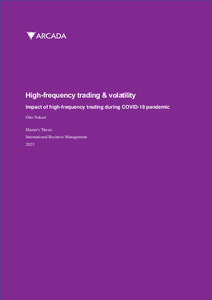High-frequency trading & volatility: impact of high-frequency trading during COVID-19 pandemic
Nakari, Otto (2023)
Nakari, Otto
2023
All rights reserved. This publication is copyrighted. You may download, display and print it for Your own personal use. Commercial use is prohibited.
Julkaisun pysyvä osoite on
https://urn.fi/URN:NBN:fi:amk-2023121938578
https://urn.fi/URN:NBN:fi:amk-2023121938578
Tiivistelmä
This thesis originally started with a regulatory angle, which was to find out if high-frequency trading (HFT) or algorithmic trading can be regulated and if so, how it has worked this far. The research was aimed to Australia, as many news sources were writing articles about how the regulator down there has a demand to control HFT. It ended up as a question of where to find material for this research. Later, it became clear that it is not possible to find a reliable source for this information. One reason for that is that the trades are not publicly available online or were they executed by HFT. Therefore, the topic and the hypothesis of the research were changed to be able to find more information from open sources. The hypothesis was actually changed several times from a statistical F-Test to a less statistical to get results which could analysed in a clear way. The research questions were “Does high-frequency trading amplify market volatility? If yes, how much has high-frequency trading amplified the market during the COVID-19 pandemic?” The analysis was conducted by comparing the assumed portion of HFT (30%) with the previous year’s volume and rationalizing it with the previous research done on this topic. The results match the existing market share of HFT, but it is still not undisputable that HFT has amplified the market volatility during the COVID-19 pandemic.
